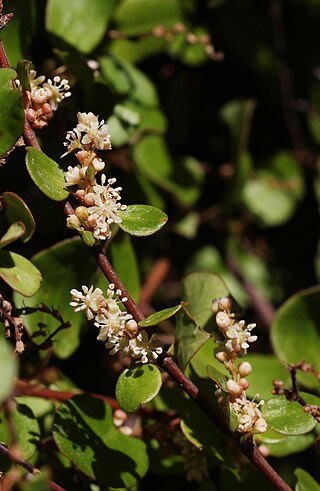
The Reduviidae is a large cosmopolitan family of the suborder Heteroptera of the order Hemiptera. Among the Hemiptera and together with the Nabidae almost all species are terrestrial ambush predators; most other predatory Hemiptera are aquatic. The main examples of non-predatory Reduviidae are some blood-sucking ectoparasites in the subfamily Triatominae, with a few species from South America noted for their ability to transmit Chagas disease. Though spectacular exceptions are known, most members of the family are fairly easily recognizable: they have a relatively narrow neck, sturdy build, and formidable curved proboscis. Large specimens should be handled with caution, if at all, because they sometimes defend themselves with a very painful stab from the proboscis.

Muehlenbeckia complexa is a plant commonly known as pohuehue, although this name also applies to some other climbers such as Muehlenbeckia australis.
Diadema is the term for diadem in most Romance languages, and in English may refer to:

The Harpactorinae are a large subfamily of the Reduviidae. About 300 genera and 2,000 species worldwide have been described. Some of the species of the genera Zelus, Pselliopus, Sinea, and Apiomerus are of interest as biological pest control agents.

Sinea is a New World genus of assassin bugs, in the subfamily Harpactorinae. 13 species have been described, mostly from the Southwestern United States and Central America.

Sinea diadema is a species of assassin bug family (Reduviidae), in the subfamily Harpactorinae. Sinea diadema is bivoltine, preys on small bugs and beetles, and overwinters in the egg stage.
Ostrocerca is a genus of spring stoneflies in the family Nemouridae. There are about six described species in Ostrocerca.
Aradus behrensi is a species of flat bug in the family Aradidae. It is found in North America.
Aradus inornatus is a species of flat bug in the family Aradidae. It is found in North America.

Aneurus simplex is a species of flat bug in the family Aradidae. It is found in North America.
Aradus acutus is a species of flat bug in the family Aradidae. It is found in North America.
Largus pallidus is a species of bordered plant bug in the family Largidae. It is found in North America.
Aneurus borealis is a species of flat bug in the family Aradidae. It is found in North America.
Aradus intectus is a species of flat bug in the family Aradidae. It is found in North America.
Sinea rileyi is a species of assassin bug in the family Reduviidae. It is found in Europe and Northern Asia and North America.
Mezira pacifica is a species of flat bug in the family Aradidae. It is found in North America.
Aradus basalis is a species of flat bug in the family Aradidae. It is found in North America.
Sinea anacantha is a species of assassin bug in the family Reduviidae. It is found in North America.

Sinea coronata is a species of assassin bug in the family Reduviidae. It is found in the Caribbean Sea, Central America, and North America.
Ostrocerca complexa, the notched forestfly, is a species of spring stonefly in the family Nemouridae. It is found in North America.




